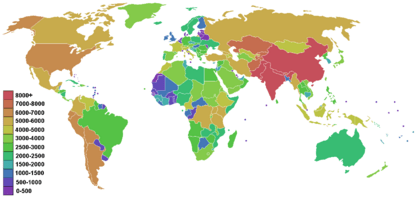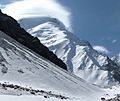List of elevation extremes by country facts for kids
Every country has places that are very high, like mountains, and places that are very low, like valleys or coastlines. These are called "elevation extremes." Thinking about how high or low a place is helps us understand the Earth's surface.
Elevation means how far a spot is above a special imaginary line called the geoid. You can think of the geoid as the average level of the ocean, stretching all around the world. So, when we talk about elevation, we're usually talking about how high a place is above sea level.
Contents
What are Elevation Extremes?
Elevation extremes show us the highest and lowest points in a country or territory. This helps us see how much the land changes from one spot to another.
Highest and Lowest Points Around the World
The world's highest point is the top of Mount Everest, which is an amazing |rowspan=1 align=center|8848 m
29,029 ft meters (about 29,031 feet) above sea level. The lowest point on land is the Dead Sea, which is |rowspan=1 align=center|−428 m
−1,404 ft meters (about 1,404 feet) below sea level!
Many countries have their lowest points at sea level, especially those with coastlines. But some countries have very low points that are actually below sea level, like the Qattara Depression in Egypt or Ayding Lake in China.
Some of the highest points in the world are:
- Mount Everest in China and Nepal
- K2 in Pakistan
- Kangchenjunga in India
- Aconcagua in Argentina
- Denali in the United States
- Kilimanjaro in Tanzania
How Much Do Elevations Change?
The difference between a country's highest and lowest points is called its "elevation span." This tells us how much the land varies within that country.
China has the biggest elevation span of any country, with a huge difference of 9,002 m (29,534 ft) between its highest point (Mount Everest) and its lowest point (Ayding Lake). Other countries with very large elevation spans include Nepal, Pakistan, and India.
On the other hand, some small island countries have very small elevation spans. For example, Maldives and Tuvalu have their highest points only about 5 m (16 ft) above sea level. This means their land is very flat and close to the ocean. These countries are especially sensitive to changes in sea level because their land doesn't rise very high.
Even tiny places can have interesting elevation changes. For instance, Monaco, a very small country, has a difference of 140 metres (460 ft) between its highest and lowest points, which is a lot for its size! In contrast, a huge country like Australia has a much smaller difference in elevation across its vast area.
Images for kids
-
The summit of Mount Everest is the highest point on Earth.
-
The summit of Kangchenjunga is the highest point of India.
-
The summit of Gangkhar Puensum is the highest point of Bhutan.
-
The summit of Ismoil Somoni Peak is the highest point of Tajikistan.
-
The summit of Noshakh is the highest point of Afghanistan.
-
The summit of Jengish Chokusu is the highest point of Kyrgyzstan.
-
The summit of Khan Tengri is the highest point of Kazakhstan.
-
The summit of Aconcagua is the highest point of Argentina, the Americas, the Western Hemisphere, and the Southern Hemisphere.
-
The summit of Ojos del Salado is the highest point of Chile.
-
The summit of Nevado Sajama is the highest point of Bolivia.
-
The summit of Chimborazo is the highest point of Ecuador and the farthest point from the center of the Earth.
-
The summit of Denali is the highest point of the United States and North America.
-
The summit of Mount Logan is the highest point of Canada.
-
The summit of Kilimanjaro is the highest point of Tanzania and Africa.
-
The summit of Mount Vinson is the highest point of Antarctica and the Antarctic.
-
The summit of Puncak Jaya is the highest point of Indonesia, the Island of New Guinea, and all ocean islands.
-
Lago Enriquillo is the lowest point of the Dominican Republic and all ocean islands.
-
The Badwater Basin in Death Valley is the lowest point of the United States and North America.
-
The Qattara Depression is the lowest point in Egypt.
-
Aydingkol is the lowest point of China.
See also
- List of elevation extremes by region
- List of highest points of African countries
- List of highest points of Asian countries
- List of highest points of European countries
- List of highest points of Oceanian countries
- List of tallest mountains in the Solar System
- Geodesy
- Geoid
- Nadir
- Summit
- Topographic elevation
- Topographic isolation
- Topographic prominence
- List of countries by average elevation
- List of sovereign states
- List of U.S. states by elevation
- Category:Highest points
- Category:Lowest points




























